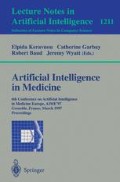Abstract
This paper presents a new model for the segmentation and analysis of living cells. A multi-agent model has been developped for this application. It is based on a generic agent model, which is composed of different behaviors: perception, interaction and reproduction. The agent is further specialized to accomplish a specific goal. Different goals are defined from the different components of the cell images. The specialization specifies the parameters of the behaviors for the achievement of the agent's goal. From these goal-oriented agents, a society is defined, and it evolves dynamically as the agents are created and deleted. An internal manager is integrated in the agent to control the behavior's execution. It makes use of an event-driven scheme to manage the behavior priorities. The present design is mainly oriented toward image segmentation, but includes some features on tracking and motion analysis.
Preview
Unable to display preview. Download preview PDF.
References
O. Baujard and C. Garbay. KISS: a multiagent segmentation system. Optical Engineering, 32(6):1235–1249, 1993.
F. Bellet, J.M. Salotti, and C. Garbay. Une approche opportuniste et coopérative pour la vision de bas niveau. Traitement du Signal, 12(5):479–494, 1995.
O. Boissier, Y. Demazeau, G. Masini, and H. Skaf. Une architecture multi-agents pour l'implémentation du bas niveau d'un système de compréhension de scènes. In 2ièmes journées francophones IAD et SMA, 1994. Voiron (France).
A. Boucher, A. Doisy, X. Ronot, and C. Garbay. Cell migration analysis after in vitro wounding injury with a multi-agent approach. Artificial Intelligence Review Journal. under revision.
A. Boucher and C. Garbay. A multi-agent system to segment living cells. In Proceedings of the 13th ICPR 96, volume 3, pages 558–562, 1996. Vienna (Austria).
R. A. Brooks. Intelligence without representation. Artificial Intelligence, 47:139–159, 1991.
F. Cloppet-Oliva and G. Stamon. Segmentation coopérative région/contour pour une analyse automatique d'images de cellules en culture. In Proceedings of 10e congrès RFIA, volume 2, pages 1063–1072, 1996.
J.-P. Cocquerez and S. Philipp. Analyse d'images: filtrage et segmentation. Masson, 1995.
R.B. Dickinson, S. Guido, and R.T. Tranquillo. Biased cell migration of fibroblasts exhibiting contact guidance in oriented collagen gels. Ann. Biomed. Eng., 22:342–356, 1994.
A. Doisy, S. Paillasson, P. Tracqui, F. Germain, F. Leitner, M. Robert-Nicoud, and X. Ronot. In vitro dynamics of chromatin organization and migration. Cell Biol. Toxicol., 12:363–366, 1996.
J. Ferber. Les systèmes multi-agents: vers une intelligence collective. InterEditions, 1995.
K.S. Fu and J.K. Mui. A survey on image segmentation. Pattern Recognition, 13(1):3–16, 1981.
Z. Guessoum and M. Dojat. A real-time agent model in a asynchronous-object environment. In Proceedings of MAAMAW, pages 190–203, January 1996.
S.H. Gwydir, H.M. Buettner, and S.M. Dunn. Non-rigid motion analysis of the growth cone using continuity splines. ITBM, 15(3):309–321, 1994.
H. Kondo, R. Matsuda, and Y. Yonezawa. Autonomous migration of human fetal skin fibroblasts into a denuded area in a cell monolayer is mediated by basic fibroblast growth factor and collagen. In Vitro Cell Dev. Biol., 29A:929–935, 1993.
F. Leitner, S. Paillasson, X. Ronot, and J. Demongeot. Dynamic functional and structural analysis of living cells: new tools for vital staining of nuclear DNA and for characterization of cell motion. Acta Biotheoritica, (43):299–317, 1995.
F. Leymarie and M.D. Levine. Tracking deformable objects in the plane using an active contour model. IEEE Trans. on PAMI, 15(6):617–634, 1993.
C.E. Liedtke, T. Gahm, F. Kappei, and B. Aeikens. Segmentation of microscopic cell scenes. AQCH, 9:197–211, 1987.
P. Maes. How to do the right thing. Connection Science Journal, 1(3), 1989.
S. Naudet, L. Nicolas, C. Faye, and M. Viala. Suivi temporel 3D d'objets en présence d'occultations dans une séquence d'images monoculaires. In Proceedings of 10e congrès RFIA, volume 2, pages 849–858, 1996.
N.R. Pal and S.K. Pal. A review on image segmentation. Pattern Recognition, 26(9):1277–1294, 1993.
F. Siegert, C.J. Weijer, A. Nomura, and H. Miike. A gradient method for the quantitative analysis of cell movement and tissue flow and its application to the analysis of multicellular Dictyostelium development. J. Cell Sci., (107):97–104, 1994.
L. Steels. Cooperation between distributed agents through self-organization. In DAI, volume 1, pages 175–196. Elsevier Science, 1990.
K. Wu, D. Gauthier, and M.D. Levine. Live cell image segmentation. IEEE Trans. on Bio. Eng., 42(1):1–12, 1995.
Author information
Authors and Affiliations
Editor information
Rights and permissions
Copyright information
© 1997 Springer-Verlag Berlin Heidelberg
About this paper
Cite this paper
Boucher, A., Garbay, C., Doisy, A., Ronot, X. (1997). A society of goal-oriented agents for the analysis of living cells. In: Keravnou, E., Garbay, C., Baud, R., Wyatt, J. (eds) Artificial Intelligence in Medicine. AIME 1997. Lecture Notes in Computer Science, vol 1211. Springer, Berlin, Heidelberg. https://doi.org/10.1007/BFb0029476
Download citation
DOI: https://doi.org/10.1007/BFb0029476
Published:
Publisher Name: Springer, Berlin, Heidelberg
Print ISBN: 978-3-540-62709-8
Online ISBN: 978-3-540-68448-0
eBook Packages: Springer Book Archive

